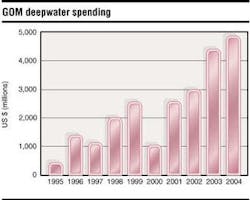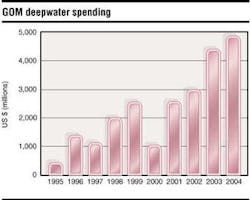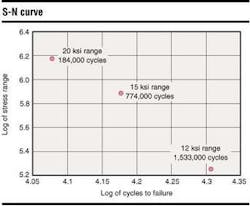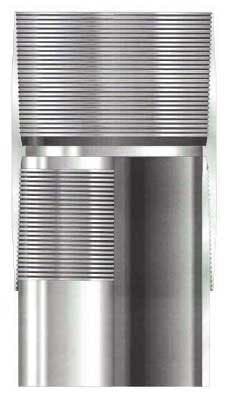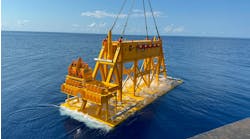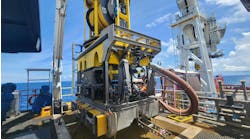DEEPWATER OPERATIONS: Development, applications of thread-on deepwater production riser connections
Deepwater plays represent one of the most promising areas of exploration for the oil and gas industry. Beneath the five primary deepwater basins - US Gulf of Mexico, West Africa, Brazil, Asia-Pacific, and offshore Europe - are potential reserves exceeding 100 billion bbl of oil. Known deep-water reserves exceed 30 billion bbl of oil and 75 tcf of gas, and industry experts estimate that more than 2,500 wells would have to be drilled during the next three decades to access those hydrocarbons alone.
Deepwater prospects are becoming an increasingly important element of the E&P programs of most major oil companies and a growing number of independents. A recent forecast predicts that approximately 200 deepwater and another 20 ultra-deep (over 5,000 ft water depth) wells will be drilled in the Gulf of Mexico during 2002, and deepwater E&P expenditures are expected to continue to increase for the foreseeable future.
Top-tensioned production risers were first introduced during the 1970s to protect production casing and tubing used on deepwater tension leg platforms (TLPs) from marine currents and corrosion. The earliest production risers functioned as conduits connecting the riser conductor piles at the seabed to the "dry-tree wellhead," thereby facilitating well intervention. As platform technology improved, top-tensioned production risers were utilized on both TLP and SPAR platform configurations.
On SPARs, production risers work in concert with the mooring system to keep the platform stable and properly oriented. Risers are held in tension by means of feedback-controlled dynamic tensioning systems, buoyancy cans, or static tie-offs to the platform. The tension applied to the production risers adds to the stability of the platform. Production risers are typically attached to the seafloor by means of a riser conductor pile and a tapered stress joint. In most cases, the tapered stress joints are made out of titanium and insulated from the rest of the riser by an electrical insulating cross-over connector.
In the recent past, top-tensioned production risers have been built using specialty tubulars possessing chemistries suitable for welding and threaded "weld-on" connectors. The connectors, in turn, were often manufactured from costly A707 material to enhance their weldability and to reduce the need for post-weld stress relieving. The massive size of these highly specialized, weld-on connectors relative to the riser pipe reduced stress and fatigue levels while protecting the conventional production casing, presenting an adequate - although expensive - solution.
Challenge
As technology significantly extended the practical reach of deepwater hydrocarbon exploration and production during the 1990s, a major oil company approached us about the feasibility of designing a new class of production riser connections that could be machined directly onto the wall of the oil country tubular goods (OCTG) riser pipe, an approach that has proven to be an economically attractive alternative to welding on specialty tubulars, especially in lower-stress sections of the riser string. Among the critical performance properties considered by engineers as they worked on the design of the top-tensioned production riser connection were pressure, axial load, and fatigue resistance.
The new production riser connection required a gas-tight seal and an internal pressure (burst) rating greater than the pressure capability of the riser pipe. The connection also needed protection from exposure to seawater, as well as an external pressure (collapse) rating exceeding that of the riser pipe. Furthermore, to ensure adequate axial load resistance, the compression and tension ratings of the riser connection, at a minimum, had to approach the load capability of the riser pipe.
Finally, the connection's fatigue resistance properties needed to be adequate for the riser's intended service in relatively benign subsea conditions. Top-tensioned production riser connections must withstand the cyclic loading of both wave action and subsurface currents acting on the riser body (vortex-induced vibrations). For the most severe environments, connections typically need stress concentration factors (SCF) of 2 or less. However, in regions where longer wave periods and calmer subsea currents characterize the sea state (offshore West Africa, Brazil, and Indonesia), a connection with slightly higher SCF values was acceptable.
Past is prologue
Furthermore, the TC-II connection's primary internal metal-to-metal radial flank seal reduces the effects of tensile load and torque on seal integrity. Seal bearing pressure is generated by radial interference controlled by precise dimensional control of the mating parts rather than field makeup conditions. The seal is pressure-energized and is available with an optional TeflonRegistered seal ring that provides a back-up sealing mechanism. However, this versatile connection is fully rated in internal and external pressure without the seal ring.
The TC-II connection's stress and interference levels are controlled by the positive makeup position provided by the 15 degrees reverse angle internal torque shoulder. The design provides a smooth ID that reduces turbulence. Additionally, the standard TC-II coupling is specifically designed for each size and weight. The coupling tensile strength is "matched" to the pipe body while maintaining maximum clearance.
The performance of the TC-II connection has been thoroughly evaluated in accordance with industry standard test formats, including a series of in-house tests conducted to the accepted API RP5C5 format. Several major operators have qualified this connection by way of a process that requires successful physical testing per the requirements of API RP5C5, ISO CD 13679, and the operator's proprietary connection evaluation programs. In addition, performance of several sizes has been verified by finite element analysis (FEA). Equally importantly, the versatile TC-II connection has enjoyed a stellar field history, performing well in the deepwater Gulf of Mexico, Eastern Malaysia, North Dome Qatar, offshore eastern Canada, and Mobile Bay.
Design and testing
To meet the performance parameters, engineers modified the TC-II connection to enhance fatigue resistance. The prototype connection was then subjected to physical testing to ensure that it would satisfy the operator's pressure, axial load, and fatigue resistance requirements. Fatigue resistance tests were conducted by the operator on several sizes of the high fatigue resistance (HFR2) connection at Oklahoma State University.
Conducting physical tests to produce sufficient data for an accurate stress-cycle (SN) curve is a time-consuming and costly operation. Establishing a stress concentration factor (SCF) for the riser connection is preferable and enables structural engineers to predict a riser's likely fatigue life. An SCF is dependent both on the geometry of the connection and on the magnitude of the load. Under a given load, the geometric discontinuity of the riser connection coupling and threads creates areas of high stress, or stress concentrations, relative to the nominal stress level in the pipe body. These geometric discontinuities are called stress risers.
FEA is a standard numerical technique for computing stress variations within a structural member and is also a preferred method of determining a connection's SCF. FEA divides a mathematical model of the riser connection into a number of smaller sections (elements). The stress and strain on each element is represented by a set of linear algebraic equations that can be solved after application of the appropriate boundary conditions.
For a given load condition, the FEA determines the maximum stress in the riser connection. The ratio of the maximum connection stress change to the nominal pipe body stress change is the SCF for the riser connection. Because the SCF is related to the change in the pipe body stress, the riser designer can use this number to calculate the expected life of the connection under the anticipated circumstances.
Finite element analysis produces graphical output, illustrating all the stresses and strains and their individual components. In addition, the output database can be queried for the stresses at discreet locations, making it possible to calculate the change in stresses and determine the maximum SCF.
Applications, advantages
The HFR1TM and HFR2TM connections can be used in both TLP and SPAR platforms as part of single barrier and dual barrier production riser applications, respectively. In a single-barrier riser system, the top-tensioned production riser is the only conductor protecting the production casing and tubing from the environment. In a dual-barrier system, a smaller diameter secondary conductor is placed inside the primary barrier for added casing and tubing protection. Use of these threaded and coupled connections on conventional OCTG represents considerable material cost savings while reducing the platform's buoyancy requirements.The "wetted" single barrier riser system utilizes the HFR1 connection, which was used by a large, independent oil producer on a SPAR platform in 2,000 ft water depth after fatigue testing by Stress Engineering in Houston, Texas, verified that the new connection's performance would meet the operator's requirements. The production riser string design called for special joints at the top and bottom of each string, but the major portion of the riser was made up of the HFR1 connections. Two different options have been developed to enhance the performance of the HFR1 "wetted" riser connection, which can be modified to contain either an elastomeric or a metallic seawater exclusion device to prevent salt water from coming in contact with the connection's threads.
While the new connection's design utilizes the basic structure and sealing mechanism of the TC-II connection, the design of the HFR1 thread form reduces the stress concentration factor at the last engaged thread, thereby enhancing the HFR1 connection's fatigue resistance.
The solution for dual barrier riser systems is the HFR2 connection, developed specifically for use as part of an inner riser on a major operator's TLP in 4,000 ft water depth in the Gulf of Mexico. This connection utilizes a coupling with an extended bevel to provide a smooth transition from the connection to the pipe body, thereby reducing stress concentrations and improving fatigue resistance. The same operator also used the HFR2 connection on its 13-chrome production tubing. Another recent application of the HFR2 connection is in the inner barrier of a dual barrier riser system on an independent oil company's Gulf of Mexico SPAR.
Conclusion
As offshore drilling moves into deeper water, the economics for thread-on riser connections will become increasingly compelling. The HFR1 and HFR2 connections enhance riser performance and economics for deepwater and ultra-deepwater E&P operations by simultaneously reducing riser tubular costs, corrosion risk, and platform buoyancy requirements.
The new class of OCTG-compatible production riser connections represents an economically attractive alternative to welding connections on specialty tubulars, especially in lower-stress sections of the riser string. Early applications on a TLP and two SPAR platforms in the Gulf of Mexico suggest that the HFR thread-on production riser connections may well represent enabling technology for cost-effective exploitation of deepwater oil and gas reserves in certain types of offshore environments.
